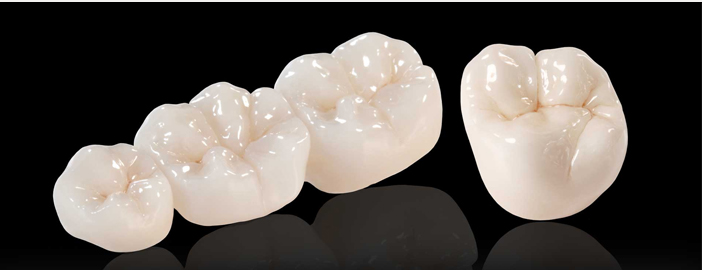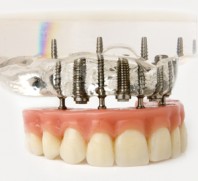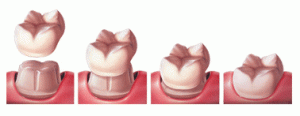Dental Crowns

A Dental Crown is basically a tooth cover that completely encircles, or ‘caps’ a tooth that lies outside of the gums. Dental crowns are often required when a large cavity threatens the health of a tooth. They are usually bonded to the tooth using dental cement, and improve the strength of a tooth as well as its appearance.
Why Would You Need a Dental Crown?
- To strengthen, support and hold in place fragments of a broken tooth
- To cover and support a tooth with a large filling when there aren’t a lot of tooth left
- To guard or protect weak and decayed teeth from breaking
- To support a dental bridge and hold the bridge in place
- To restore an already broken tooth or a severely worn down tooth
- To cover deformed or severely stained teeth
- To conceal a dental implant
What Are Dental Crowns Made Of?
Metal Crown: This is a common choice among dentists for damaged teeth which need restoration, support and protection. Metal dental crowns are typically used for molars, or other teeth that are not in plain view. The most popular metal used in metal crowns is gold. Other metals which are utilized as dental crowns include palladium, nickel or chromium. These metal crowns doesn’t chip or crack easily. Metal crowns are stronger, more durable and lasts much longer than other types of dental crowns. For the patients who prefer metal crown, only a small part of the damaged tooth is needed to be removed. Metal dental crowns are more popular because they are a bit more comfortable than other crowns when you bite down or chew on the teeth.
Porcelain Crown: Porcelain crowns look very similar to natural teeth, and can be colored to match the teeth next to them. They are very popular for their cosmetic appearance. Porcelain crowns capture and reflect light the way natural teeth do; this gives them a more natural look, making it a popular choice for most. Porcelain crowns are commonly utilized for front teeth. They are smooth and are durable, but they chip more often than metal crowns.
All-Resin Crown: All-resin dental crowns cost less than other dental crown types. They are also less durable and are more likely to wear down faster, chip or crack than other types of dental crowns.
Combination Crown: A combination crown is a dental crown made of both metal and porcelain. Gold is the popular metal of choice of combination crown. Combination dental crowns can be utilized for both the back teeth and front teeth. The porcelain part of the dental crown is more likely to wear down faster, chip or crack than the metal part.
Temporary Crown: Temporary crowns, which can be made in your dentist’s office, are made of acrylic or stainless steel and can be used as a temporary restoration until a permanent crown is constructed by the dental laboratory.
How is a Tooth Prepared for a Dental Crown?
Preparation of a tooth(multiple teeth) for a crown comprises of permanently removing much of the tooth’s original structure. This may include portions of the enamel that may still be healthy and structurally sound. A robust and natural tooth structure can never be replaced by the best dental crown. So teeth should only be crowned when a dentist has properly evaluated the tooth and has decided that the crown will outweigh the disadvantage of needing to remove some healthy parts of the tooth. This can be a very complex evaluation to make for the oral health professional. So various dentists may arrive at varying conclusions regarding treatment.
Usually it takes more than one visit to complete the crown and bridge work, and the additional time needed for the procedure can be a disadvantage but eventually the increased benefits of a restored tooth using dental crowns will generally balance the equation.
Examining and preparing the tooth
In preparation for a dental crown, the dentist will take some X-rays during your first visit to check the surrounding bone and the roots of the tooth receiving the crown. If the tooth is found out to have extensive decay, or if there is a risk of infection or injury to the tooth’s pulp, a root canal treatment may be required before a crown is installed.
The dentist will then anesthetize one’s tooth and gum tissue surrounding the tooth. The tooth getting the crown is filed downward laterally on the chewing surface and sides to provide room for the crown. The amount of tooth filed down is dependent on the type of crown to be used. The dentist will use filling material to build up the tooth to support the crown if a large area of the tooth is missing due to decay or damage.
Next, the dentist will use putty or impression paste to make an impression of the tooth to receive the crown after the reshaping of the tooth is completed. Impressions of the teeth above and below the tooth to receive the dental crown will also be made to ensure that the crown will not affect the recipients’ bite.
The impressions are then forwarded to a dental laboratory where the permanent crown will be made. It usually takes 2 to 3 weeks for the crown to be manufactured and returned to your dentist’s office. The dentist will also select the shade that most closely resembles the color of the neighboring teeth if the crown will be made of porcelain. During this visit, the dentist will make a temporary crown to cover and protect the prepared tooth while the crown is being manufactured. The temporary crown is made of acrylic material and is held in place using temporary cement.
Receiving the permanent dental crown. At your second trip to the dentist, they will remove the temporary crown and check the fit and color of the permanent crown. Once the fit is acceptable, a local anesthetic is used to numb your tooth and the surrounding area, and the new crown is cemented into place. It is now a permanent fixture.
How Do I Care For My Temporary Crown?
A temporary crown is not a solution. It is only TEMPORARY, so you must try to avoid eating sticky, chewy foods, which could grab or pull the crown off of the tooth. Try to avoid chewing things on the side of the mouth where the temporary crown is…instead, chew most of your food on the other side of your mouth. Watch what you eat, also avoid chewing hard foods because that could break the temp. crown, or worse, dislodge the crown, which can be very painful. You need to be careful when flossing. Instead of pulling the floss up, you should slide the floss out of the side. Lifting the floss out could pull off the temporary crown.
What Are Some Common Problems With Dental Crowns?
Discomfort or Sensitivity.Your tooth with the new dental crown can be delicate immediately after the procedure as the anesthesia begins to wear off. If the tooth that has been crowned still has a nerve in it, one may experience some sensitivity to heat and cold. The dentist will recommend that you brush with toothpaste intended for sensitive teeth. If it is painful or fragile when you bite down on the tooth, it usually means that the crown was placed too high on the tooth. If that’s the case then you should call your dentist right away, they can easily fix the problem.
Chipped Crown. Crowns made of porcelain do occasionally chip. If the chip is small, a composite resin will be used to repair the chip with the crown still in situ in the mouth. The crown will be replaced if the crown is chipped badly.
Loose Crown. The cement used in the crown could sometimes wash out from under the crown. This allows bacteria to leak into the crown and could enable decay into the tooth that remains. This can also the crown to become loose. Contact your dentist immediately if the crown feels not fixed in place.
Crown Falling Off.This happens mostly because of an improper fit or the lack of cement to hold the crown in place. When this happens, you should clean the crown and the tooth, then you can replace the crown temporarily with some dental adhesive or temporary tooth cement. You should also call your dentist. They can provide specific instructions on how to care for the crown and tooth until the tooth can be reevaluated. The dentist can re-cement the crown in place and if not, a new crown will be needed to be made.
Allergic Reaction.This is extremely rare but can happen. A mix of different metals is utilized to manufacture the crowns and an allergic reaction to the metals or porcelain used in the crown can occur.
Dark lines on the crowned tooth.
If you have a porcelain-fused-to-metal crown, a dark line next to the gum line of one’s crowned tooth can appear. This is normal. The darker edge is just the metal of the crown showing through.
What Are Onlays and ¾ Crowns?
Onlays and 3/4 crowns are variations of dental crowns. The major difference between a regular crown and an onlays and 3/4 crowns is the amount of the tooth that is covered. An onlay and a 3/4 crown do not cover the entire tooth, just the area that needs coverage.
How Much Does A Crown Cost?
The price of your dental crown depends on the location and the kind of crown that you need. It can also depend on where you live. A crown can cost anywhere from $500 to $1,000(this is a broad average price). Your dental insurance will cover a portion of the cost, but you should confirm that with their dental insurance company.
How Do I Care For My Dental Crown?
A dental crown usually last between 5 and 15 years, this will depend on the amount of wear and tear the crown is exposed to. How long it lasts will also depend on how good your oral hygiene is. If you have a crown, you should avoid things like grinding or clenching your teeth, chewing ice, biting your fingernails and using your teeth to open bottles and packaging.
A crowned tooth does not require any special care, but you shouldn’t ignore the underlying tooth…you still need to help avoid decay and gum disease. You should continue to practice dedicated teeth hygiene: brush your teeth(at least) twice a day and floss once a day (two is better), especially around the crown where the gum meets the tooth. Always remember to practice good oral hygiene to keep both tooth and crown healthy.
by SSI VA
Categories
Recent Posts
-

Dental Implants
Dec, 30, 2015
-
General Dental Crowns
Dec, 30, 2015
-
Terms & Conditions
May, 26, 2015
-
Payment & Privacy Terms
May, 26, 2015
-
Dental Surgery
May, 26, 2015
-
Orthopedic & General Surgery:
May, 26, 2015
-
Eye Surgery
May, 26, 2015
-
Plastic Surgery:
May, 26, 2015
-
Site Map
May, 26, 2015
-
Links
May, 26, 2015













Leave a Comment